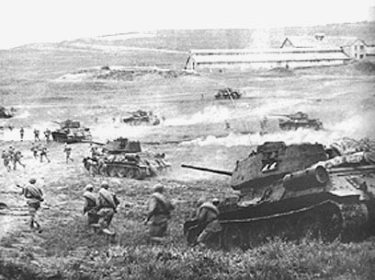The Battle of Kursk

After the defeat in the Battle of Stalingrad, the German position in Russia was very difficult. The mighty Wehrmacht that overrun the Red Army in the early stages of the Operation Barbarossa and reached the outskirts of Moscow in a few weeks was in retreat from the winter of 1943 and Hitler desperately needed a victory against Stalin's forces to boost the German morale, regain initiative in the Eastern front as well as to demonstrate the Allies the might of his forces. At the same time, a victory could win him a major political advantage over the Allies whose relations were not the best at the time. Stalin was angered with his Western Allies for postponing the planned opening of the front in Western Europe. Hitler hoped that a decisive victory over Russia would ruin the relationship between the Allies and gave him both political and military advantage. He also believed that the Allies are unlikely to launch an offensive in Western Europe, enabling him to focus on the Eastern front. Hitler decided to stop the Russian advance and try to turn the tide of the war into his favor.
Destruction of the 6th Army in the Battle of Stalingrad was a irreplaceable loss for the German Army but due to the seemingly stable situation in the Western front, Hitler decided to transfer huge force from the West to the Soviet Union. At the same time, the Wehrmacht received new and more powerful equipment, in the first place the Panther and Tiger tanks and new aircraft. In mid-April, Hitler approved the Operation Citadel which foresaw a major offensive at Kursk that was in the center of the bulge that occurred during the Russian advance to the west. If this bulge would not be eliminated, the German forces south of Orel and north of Kharkov were at risk of being encircled by the Red Army. However, Hitler postponed the offensive until July 5 by which he gave the Russians plenty of time to prepare for the German assault. In addition, the longer he postponed with the Operation Citadel the more information the Russian Intelligence received. By the time Hitler finally approved the offensive, the Russian military commanders knew exactly where the attack is about to happen, when and with what force. Before the offensive, the Russians thus started a massive artillery bombardment to confuse the Germans. And they succeeded as the Wehrmacht needed two hours to reorganize and finally launch the assault.
The command of the Soviet forces at Kursk was entrusted to generals Nikolai Fyodorovich Vatutin and Konstantin Rokossovsky who were closely supervised by Georgi Zhukov. Since the Russian generals knew about the planned German offensive, they were well prepared to defend their positions. The Soviet strategy was to let the Germans wear themselves out and then launch a counter-offensive. Thus the huge German force consisting of about 900,000 soldiers, 2,900 tanks and 2,100 aircraft was awaited by even a larger Soviet force which numbered 1,9 million men, 5,100 tanks and 2,800 aircraft.
The German offensive at Kursk started on July 5, 1943, with a simultaneous attack on the north and south of the bulge. However, the attacks were anticipated and the Red Army relatively easily repulsed the attack in the north, while the German troops in the south advanced quite well despite the fact that the new tanks proved unreliable. Nearly one quarter of the Panther tanks experienced mechanical problems and required repair. But the German advance in the south forced the Soviet generals to mobilize their reserves. Both the northern and southern armies failed to achieve their objective but the Soviet generals were not ready yet to launch a counter-offensive. Instead, generals Vatutin and Rokossovsky decided to dig in the tanks and wait for the Germans to wear themselves out. And their tactic worked as the German tanks were falling victim to the Soviet anti-tank guns.
The largest tank battle in history started on July 12 with the German attack at Prokhorovka which is about 50 miles from the city of Kursk. By nightfall, Germans lost about 350 tanks which is about one half of all German tanks that participated in the battle. The German attempt to break though the bulge failed, while the Russian generals launched a counter-offensive. The German forces were unable to withstand the Soviet assault and by July 19, the Germans were retreating. On July 23, Hitler approved his generals to withdraw and reorganize, however, the German military strength was broken and the Red Army launched a large scale counter-offensive on August 3. Within two days, the Russian troops liberated Belgorod and broke the defenses of the city of Kharkov on August 13. With the fall of Kharkov to the Red Army on August 23, the Battle of Kursk ended with a decisive Soviet victory.
The Battle of Kursk was the last German attempt to achieve a victory in the Eastern front. Afterwards, the Germans were retreating from the Soviet Union as fast as they advanced during the Operation Barbarossa in 1941. The defeat at Kursk finally ended all Hitler's hopes for victory in the East, while the successful Allied invasion of Sicily on July 12 in the same year indicated that the tide of the war was turning against the Axis.
Estimations of casualties in the Battle of Kursk vary. The Germans are estimated to lose about 70,000 men (or according to the Soviet sources as many as 500,000 men), 1,500 tanks and most aircraft. The Russian suffered heavy casualties as well, perhaps even heavier than the Germans. However, the Soviet military commanders still had reserves in manpower, while the victory in the battle dramatically lifted the morale of the Soviet soldiers.




